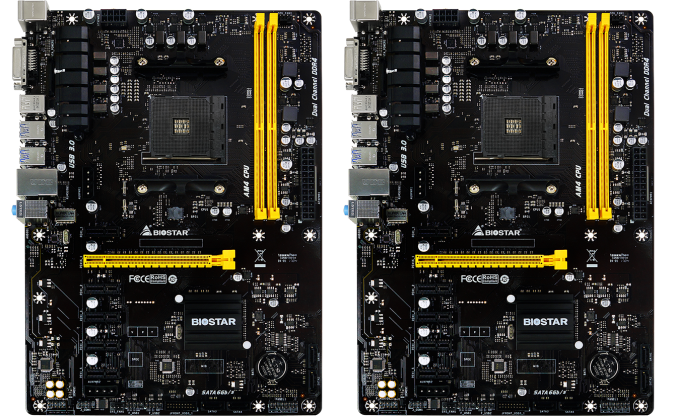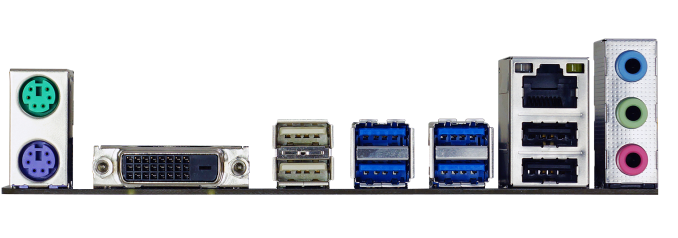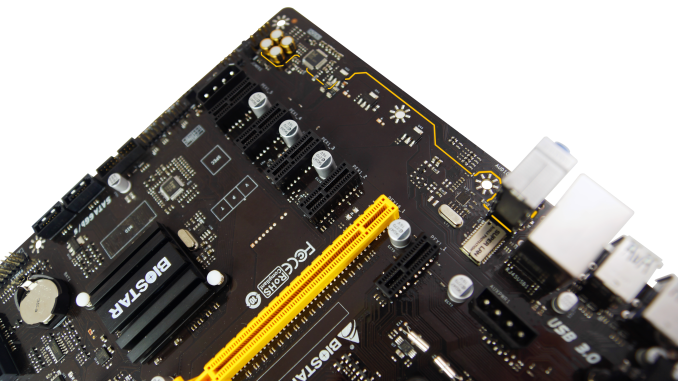BIOSTAR Reveals Two AMD AM4 Crypto Mining Motherboards
by Patrick MacMillan on May 10, 2017 1:00 PM EST
Although largely overshadowed by more efficient ASIC rigs, there are still people using GPUs to accumulate digital currencies and/or create cheap OpenCL based systems. It is with those users in mind that BIOSTAR has now expanded their lineup of specialized cryptocurrency mining motherboards to include two new AMD AM4 models.
Referred to as the TA320-BTC and TB350-BTC, these are the first AM4-based crypto mining motherboards announced, and as such make BIOSTAR the only manufacturer to offer mining motherboards for both mainstream platforms. This following the recent launch of Biostar's Intel LGA1151-based TB250-BTC model.
As you might have surmised, the TA320-BTC is based on the lower-end AMD A320 chipset, while the TB350-BTC is based on the mid-range AMD B350 chipset. After carefully scrutinizing the specifications list of both models, the only difference that we could find – chipset aside – is that the A320-based model is limited to memory speeds of DDR4-2666, while the B350 model supports up to DDR4-3200. These models only have two DDR4 memory slots each, so they are limited to 32GB of system memory.
Both motherboards support AMD's latest Ryzen processors (up to 95W TDP) and the upcoming 7th Generation A-Series APUs, which should be no problem for the 7-phase power design. Given their specialized purpose, these motherboards only have four SATA 6Gb/s ports and no M.2 slots. USB connectivity is quite decent with six USB 3.1 Gen1 ports (four rear, one header) and six USB 2.0 ports (four rear, one header). Two of the USB 2.0 ports are high amperage capable, so they can handle water pumps and/or fans that require up to 1.5 amps. Networking duties are handled by one gigabit LAN port that is powered by a Realtek RTL8111H controller. In terms of rear I/O connectivity, aside from the aforementioned ports, there are two legacy PS/2 connectors, a single DVI-D video output, and three audio jacks courtesy of a low-end Realtek ALC887 codec.
The key selling point of these two models is obviously their six PCIe slots. They each have one PCIe 3.0 x16 slot, two PCIe 3.0 x1 slots, and three PCIe 2.0 x1 slots. The PCIe x16 slot will operate at x8 if an APU is installed, due to AM4 APU limitations. Now you may be asking how PCIe x1 slots are useful when it comes to handling multiple graphics cards, and the answer is that miners use PCIe 1x to x16 riser cards with flexible extender cables (not included) and special cases that hold the graphics cards well above the motherboard. Crucially, there are also two 4-pin Molex power connectors intended to bolster power delivery to the PCIe slots, and they must be used when mining due to the increased power demands.
While full-size ATX motherboards generally measure 305mm × 244mm, these two models are both slightly shorter and narrower than the ATX standard at 295mm x 210mm. That may cause issues with certain cases, but BIOSTAR is likely betting on the fact that those who purchase these motherboards will be installing them on purpose-built open test benches.
We have no information with regard to pricing or availability, but both models will have a 3-year warranty in applicable regions. We expect the pricing to be quite low, given the margins that miners typically work with. Mining aside, any non-PCIe bandwidth limited task for compute, using OpenCL / CUDA and such could also be used.
Related Reading
Source: BIOSTAR





















22 Comments
View All Comments
ArcanuS - Tuesday, June 6, 2017 - link
I'm not engineer, but I'm into mining and as such I have 'field expertise' owning several dozens risers. Feel free to correct me where appropriate.First of all, most of us are using 'active' risers. This means that risers are supplying power to VGAs via power supply, not from MB's PCIe slot. Passive risers are supplying power to VGA from PCIe slot (before the notch pins 1-4 I think). Problem (read: real life fire hazard) with passive risers is that they need to pass on to VGA 66W@+12VDC=5.5A. That means +12VDC Cu wire should be at least 0.51mm (AVG24) at ~60cm/2ft. That's theory. In real life usage wires are not Cu, soldering is bordering on criminal intent, isolation is... well not isolation. I saw many melted passive risers bought from Ali or eBay for 3€. Also, if you put 6 VGA on the board and use only passive risers that means, MB must provide 33A@+12VDC. That is fine and well except you overload MB power lines and in some cases even PCIe holders on MB melt. Not to mention RX480 regularly draws 75W from MB's PCIe slot (without 3.3V SB power calculated)
Enter 'active' risers: They connect MB to VGA with only first signal portion of PCIe (pins 12-18, 9 wires). Pretty much all of active risers use USB 3.0 cable for this. That's why people call them USB risers. Power comes from risers. Every riser have PICe16 slot, USB type A connector and some form of PS connector (molex, 6-pin, SATA power). This power connector is used for 'cheating' VGA card and providing power to it, so VGA card thinks it's getting power from MB. Now, there are multiple types of riser power and there are reasons for using them. Some use Molex and +5VDC and do overstepping in order to supply +12VDC@5.5A. One reason for this is to relax 12VDC rail on power supply (to left it to 6-pin VGA connector). Some risers are using Molex and combine both +5VDC and +12VDC from Molex in order to supply 66W to card. Some are using SATA power connector - I presonally do not reccomend this, since SATA power connector is not designed for 66W and there are cases all over the net of melted risers and/or SATA power cables. The best ones are using +12VDC 6-pin VGA connector. Problem with them is that people who use regular PC power supply do not have, for example, 12x 6-pin connectors on their power supply for 6 cards. But you can always buy high efficency 2.6KW +12VDC power supply and use it to power both risers and cards. One note: NEVER use cheap SATA to Molex cable - that can be fire hazard.
Long answer shorten: No MB manufacturer would risk and provide cheap risers when they can not control type of cabling, PS you will use or envroinment.
ArcanuS - Tuesday, June 6, 2017 - link
This board is primarily for mining. Let's say it costs ~150€. It will pay for itself in less then a week mining with 6x480 8GB. Believe me, any Ethereum miner does not bother with cost of MB, RAM, CPU or SSD. That's like 250€ which is, at current rate, 10 days worth of mining. After 10 days I do not care if it's obsolete or not.helvete - Tuesday, August 1, 2017 - link
They should add a saw into the bundle:-)ScottSiz - Wednesday, March 11, 2020 - link
https://vk.com/id569827923 - хочу познакомитьсяGabrieljah - Friday, September 18, 2020 - link
Sit in Bitcoin waves and get a guaranteed € 13,000 for exactly 24 hoursLearn more: https://bit.ly/3iCggV1
Listen to our members who rely on our software to fund their luxury lifestyle:
Joey Feldman
When I joined the Bitcoin system 2 months ago, I could never imagine the series of events that would unfold a few days after my free software was unlocked. I managed to pay off my debt of 131,382 euros. There is nothing better than being debt free. Now I am buying my dream home. I still cannot believe that all this is really happening ... I am infinitely grateful to Steve.
Meet Steve McKay
The genius of the Bitcoin system. Hello
- I am a former software developer for a large firm, which I mention the name as a giveaway
I Compared to early investors in Uber, Facebook or Airbnb, this software is creating millionaires in record time. If you want to make a million with Bitcoin, watch the video above to see how. Your friend, Steve McKay
Jump to be the first: https://bit.ly/3iCggV1